After the house is built, it's time to start finishing it. This is required, mainly in order to bring to the state of perfection the already effectively looking walls. Indeed, many prefer to do without finishing, but this article will not go at all about this, because often this is not enough - the house still needs a competent finish. In particular, it concerns the walls. It is better, in this regard, to consult with knowledgeable experts, since the quality of the finish depends on the security of the walls, the convenience of their maintenance, and, of course, their appearance.
It should immediately be noted that the bar, before selling, is treated with wax and antiseptic, but this gives only a basic short-term protection. Precisely, the finish allows to properly protect the walls, and on how well it is made, the durability of the building depends directly.
Stages of work
Usually, the process of finishing the house is divided into two stages - the stage interior decoration and exterior decoration. Let's try to figure out what these two stages consist of.
Exterior finish
Under exterior finishing of the house from the timber , as a rule, involve such processes as:
- Sanding the surface of the beam.
- Wax removal from its ends.
- Protection of the surface of the beam of certain compositions.
- Grinding from the ends and its protection.
- Intermediate and finish coat.
Let's briefly review each of the stages presented. At the stage of grinding, a specialized technique is used, which produces all the necessary manipulations. The grinding of the material must be carried out in accordance with the configuration and construction planned to build the house. After that glued beam treated with antiseptic substances that will protect the tree from a variety of harmful organisms, such as:
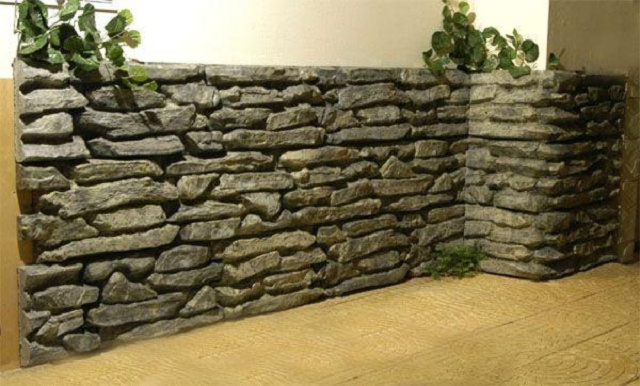
After these steps are carried out, such vulnerable material as wood becomes much more reliably protected from insects, fungi, putrefaction, fires, dampness, precipitation and rain. Very often, after the application of protective substances, the wood of the glued beam is also covered with a special compound that allows it to give a certain shade. Glued timber is treated with a special vapor-permeable coating, which provides a certain level of ventilation in the room, so that it always has a certain comfortable level of humidity.
Perhaps, at this stage, especially important is the point at which it is necessary to achieve the proper level of end protection. In order to obtain the maximum result, first a layer of varnish is removed from the surface of the beam, which is applied in the factory for its production to provide basic protection during the transportation of the product. In order to properly protect the bar, after removing the varnish, it is treated from the ends with a special sealant.
Interior finish
Under the interior decoration is understood as such moments as painting and polishing the walls. In this case, use a special vapor-permeable composition, which in its structure differs from the composition used in exterior decoration. Here, safety in terms of ecology is very important, because the interior of the house is the environment in which people live. Therefore, it is necessary to make every effort to ensure that it does not cause harm to health. For this, when processing internal surfaces, special, less intensive chemicals are used. 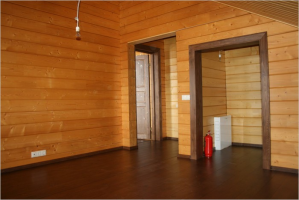
Decoration Materials
Finishing materials for such houses can be very diverse, however, they can be divided into two groups - protective and toning. The protective group includes such finishing materials that do not come into deep contact with wood and are not absorbed into it. Usually, such finishing materials are characterized by the smoothness of the surface and its cleanliness. They can boast a sufficiently high level of aesthetic appeal. To the tinting group are finishing materials, which are necessary for the wood to have a certain shade.
As a rule, such substances come into direct interaction with the beam, penetrating into the depth of one or several layers. This type of coating is characterized by the fact that it does not form a solid surface. On the contrary, it can be touchy and even slightly sticky. That is why, such a surface must necessarily be covered with protective substances. If you do not do this, dust will settle on it.
All houses built of profiled or glued timber inside look the same. Of course, you can not perform internal and external decoration, but then the rooms will not emphasize the nature of the owner, and the originality of the design is not worth talking about. If you want your house from a bar to be individual, then it's worth thinking about the finish. Interior decoration of the house from a bar is an interesting process, and the variety of materials will please the most fastidious owner. In this article, we look at some options for finishing, and tell you about the features of different materials.
Materials used for finishing inside the house
Interior decoration can perform not only declarative functions, but also to insulate or strengthen the walls after the construction of the house from the timber has been completed.
 Materials for the interior decoration of the house from a bar set, and choosing, buyers are guided only by their imagination and wallet. Judging by the reviews, the most positive are related to several popular types:
Materials for the interior decoration of the house from a bar set, and choosing, buyers are guided only by their imagination and wallet. Judging by the reviews, the most positive are related to several popular types:

Materials can be used either separately or combined. You can create an internal design yourself or attract professionals. On the Internet you can find many photos of ready-made solutions for different rooms. Selecting the design should take into account the purpose of the room, its future situation and even location (southern, northern, etc.). There are several main characteristics that a material for interior decoration should possess:
- Ecological compatibility.
- Fire resistance.
- Durability.
- Ease of installation.
- Aesthetic appearance.
- Practicality.
It is rare to find a combination of all these characteristics in one material, so usually focuses on 1-y-2 characteristics.
Before any lining of the wall from the timber, it is necessary to additionally slip and cover with 2-3 layers of antiseptic, for example Senezh (the price is from 120 rubles per liter). More details on how to do this, you can find HERE.
Decorating rooms with decorative stone
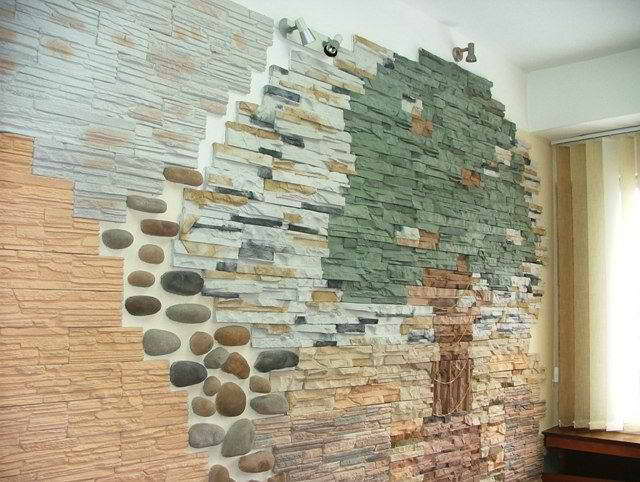 The rooms decorated with a decorative stone look original, even for the construction of a house from glued beams, but the material is expensive (from 250 rubles per square meter). And because of the evenness of the surface of the beam, it's easy to do this decoration even with your own hands.
The rooms decorated with a decorative stone look original, even for the construction of a house from glued beams, but the material is expensive (from 250 rubles per square meter). And because of the evenness of the surface of the beam, it's easy to do this decoration even with your own hands.
Characteristics of decoration with decorative stone:
- High strength and moisture resistance.
- Ecological compatibility, as the material is analogous to the natural.
- The combination of stone and wood is considered one of the most harmonious.
- Originality of design and embodiment of multiple options.
- Easy to clean from dust and dirt.
Abrasives can damage the decorative stone, so you can not clean them!
Before the installation of decorative stones, the log walls must be worn with jute or a linen cord. A small weight of the material makes it possible to attach it to any flat surface. It is sufficient to level the surface before laying with GKL or plaster. For rooms with high humidity take GVL or moisture resistant plaster. GKL is fastened to the beam with the help of the bridging of blocks of 50x25 mm, but if the bar is even then you can sew the material directly to the wall. The lining allows additional insulation of the walls, laying the insulation.
To install a decorative stone you will need:
- Material.
- Adhesive composition on cement.
- Spatulas.
- Level.
- Putty
Features of installation of a decorative stone
 Initially, using the level, the straight line is measured, from which the masonry will occur. Of course in many respects it is the envy of the form of the material. There are species that are placed chaotically, but you still need to try to ensure that each stone is laid, exactly in the vertical and horizontal. If the laying is carried out on a small area of the wall, it is better to plot the plot in advance.
Initially, using the level, the straight line is measured, from which the masonry will occur. Of course in many respects it is the envy of the form of the material. There are species that are placed chaotically, but you still need to try to ensure that each stone is laid, exactly in the vertical and horizontal. If the laying is carried out on a small area of the wall, it is better to plot the plot in advance.
The adhesive composition is diluted with water, according to instructions and put a spatula on the stone and the wall. The second spatula is needed to remove excess glue. The level needs to check each element separately. The distance between the stones should be as small as possible.
At the end of the seams are smeared with special putty, they seal and prevent dirt from entering. Such putties stand from 200 rubles / 5 kg.
Finishing the room with a lining, block house
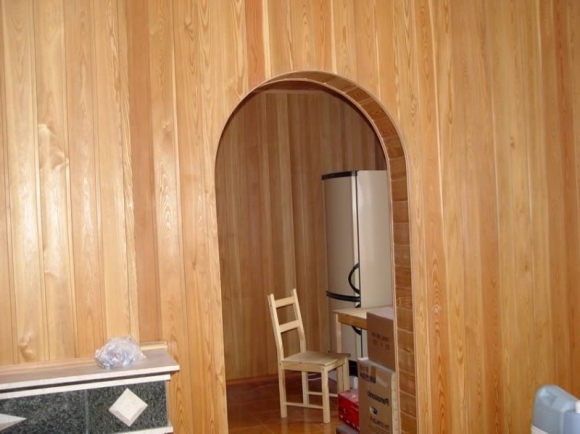 By the method of attachment, these materials are similar, so to consider each separately does not make sense. Siding is used to finish the inside of the house from the timber rarely, but the lining and block house fell in love with the owners. Finishing of these materials is carried out holistically and does not require additional processing. The exception is an unpainted lining, which is completely covered with paint or paint coatings.
By the method of attachment, these materials are similar, so to consider each separately does not make sense. Siding is used to finish the inside of the house from the timber rarely, but the lining and block house fell in love with the owners. Finishing of these materials is carried out holistically and does not require additional processing. The exception is an unpainted lining, which is completely covered with paint or paint coatings.
The main advantages of the material include:
- The plastic version has a high moisture resistance, and the wooden version does not disturb the ecological compatibility of the house from the timber.
- Easily cleared of dirt and dust.
- Just mounted.
- Durable material.
- Large version of color solutions.
- Can be combined in colors or with other materials.
For work you will need:
- Material and components (for siding and block house)
- Screwdriver.
- Bruski 25h50 mm - without a heater and 50x40 with a heater.
 The lining is fixed to the walls in 40 cm steps, perpendicular to the lining of the lining or block house. A vapor barrier and a heater is laid (for more details, see the article about the insulation of a wooden house from the inside).
The lining is fixed to the walls in 40 cm steps, perpendicular to the lining of the lining or block house. A vapor barrier and a heater is laid (for more details, see the article about the insulation of a wooden house from the inside).
Features of installation of lining and block house
With the aid of a level and a screwdriver, the guide bar is fixed, the first link of the skin will go from it. To fasten the lining and the block house from a tree it is necessary by means of thin nails. There are two ways: the nail is hammered into the lock and from above. Plastic panels are fixed with screws using a screwdriver. It is worth noting that the vertical mount visually increases the height of the ceiling, and horizontally expands the room.
Finishing of GKL or GVL
 Drywall (GKL) is used for interior finishing after the construction of a house from a profiled beam or if the walls are uneven. But do not make such a skin in small rooms, as the construction steals the area. Use GKL can be used for finishing walls and ceiling. For rooms with high humidity (bathroom, kitchen, etc.) use moisture-proof analogue GVL. The material costs from 300 rubles. for a sheet of 2500x1250 mm.
Drywall (GKL) is used for interior finishing after the construction of a house from a profiled beam or if the walls are uneven. But do not make such a skin in small rooms, as the construction steals the area. Use GKL can be used for finishing walls and ceiling. For rooms with high humidity (bathroom, kitchen, etc.) use moisture-proof analogue GVL. The material costs from 300 rubles. for a sheet of 2500x1250 mm.
The main advantages of finishing GKL:
- Aligns the walls.
- Easy to install.
- It is not expensive.
- Finishing GKL implies further decoration (painting, wallpapering, etc.)
- The sheet is quite heavy and it's hard to fix it to the ceiling alone.
- If we take a small thickness, it can break at impact.
- It is poorly stored, therefore, after acquiring it is better to begin work immediately.
For work you will need:
- Bars or special profile.
- Self-tapping screws (special with wide hat).
- Screwdriver.
GKL mounting features
Interior finishing of the house from the GKL bar starts with a billet of bars or a metal profile. Mount the crate from the corner with a step of 40 - 50 cm between the crate is laid insulation and vapor barrier.
On the crate with the help of screws mounted GKL. Each sheet is attached with at least 9 screws. 
Docking sheets between each other is easy, because you can cut the right size with a stationery knife or jigsaw. At the end of the stitches are stuccoed. From above, you can apply decorative plaster, paint or paste wallpaper.
Finishing of premises from laminated veneer lumber
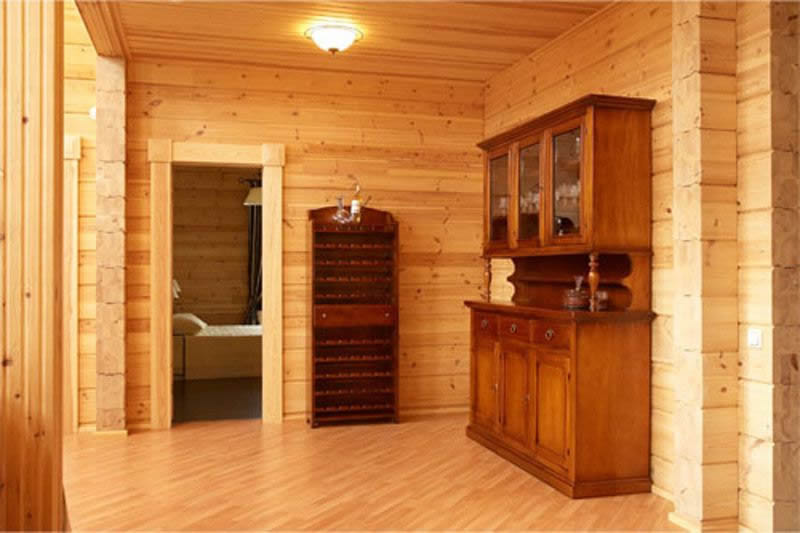 I want to highlight the glued beam, because the construction of this material is not cheap and to hide even and beautiful walls under the hull do not want.
I want to highlight the glued beam, because the construction of this material is not cheap and to hide even and beautiful walls under the hull do not want.
After the construction, the glued beams must be ground and covered with antiseptics.
Coating compositions are used for finishing:
- Varnishes (glossy, matte and semi-glossy).
- Paints
- Wax mastics.
- Oils
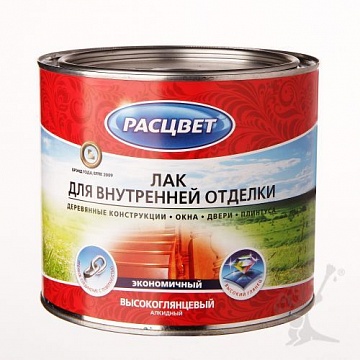 For internal painting it is better to take a varnish on a water basis, since it does not have a sharp odor and dries quickly. For common-use rooms use lacquer with glossy gloss, for bedrooms and children's matte or semigloss. It is necessary varnish depending on the manufacturer from 250 rub./l. In order to save, you can take a nitric, but they need to paint in the summer with good ventilation and dry it will be more than 1 day.
For internal painting it is better to take a varnish on a water basis, since it does not have a sharp odor and dries quickly. For common-use rooms use lacquer with glossy gloss, for bedrooms and children's matte or semigloss. It is necessary varnish depending on the manufacturer from 250 rub./l. In order to save, you can take a nitric, but they need to paint in the summer with good ventilation and dry it will be more than 1 day.
Paints for interior works
Paints are also better to take on a natural basis. They dry quickly and are easily applied. Choosing a color solution, you need to repulse from: the appointment of the room and its location. So, on the southern side it is better to use cold shades, and from the northern, on the contrary warm. There is a paint from 500 rubles / 10 liters.
Wax Mastic
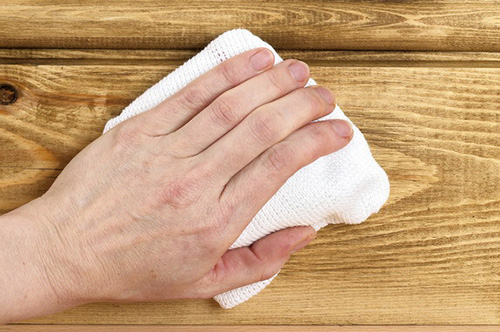 This is one of the most expensive coatings. But the glued beam will breathe because there will be no film on the surface. Wax mastic protects the glued material from moisture and has many shades. The walls after the wax look noble and preserve the natural pattern. Wax is worth 350 rubles / liter.
This is one of the most expensive coatings. But the glued beam will breathe because there will be no film on the surface. Wax mastic protects the glued material from moisture and has many shades. The walls after the wax look noble and preserve the natural pattern. Wax is worth 350 rubles / liter.
Oils for timber
Glued laminated timber inside the house is covered with natural oils: linen or Danish cold pressed. The oils are absorbed into the bar and give it a golden hue. In this case, the coating protects the walls from moisture and bacteria. The treatment with oils should be carried out with a brush or roller.
More about applying various types of coatings on glued lumber we have already said HERE.
The installation of any of the finishes, although it seems simple, is actually laborious and requires more time. If you do not have neither the first nor the second, it is better to contact specialists.
Contemporaries appreciated warm, practical houses from different types of timber. Presentable facades of such buildings do not require additional decoration works, and wooden walls contribute to the creation of a pleasant microclimate in the house regardless of the season. When carrying out the interior finishing of the timber house, it is necessary to harmoniously combine traditional comfort, maximum naturalism and innovative technological solutions.
Professionals strongly recommend that before the beginning of the finishing works inside the wooden structure, a project be drawn up that clearly shows the final goal. Detailed estimates will determine an approximate budget, help to plan expenses. On the perimeter of the premises along the walls are laid all engineering communications. According to the list, rough materials for the processing of the timber massif, decorative coatings, auxiliary elements are purchased.
Wooden houses are exposed to fungal cultures and can be attractive to many insects. Therefore, before the main finish begins, high-quality processing of the bar with antiseptic solutions is required - they can be purchased at any specialized point. It is also recommended the use of compositions that increase the fire resistance of a wooden structure, coating surfaces with water repellent.
If the climate of the area is severe enough, and the house is designed for year-round living, then it is necessary to take care of additional insulation of the walls with any environmentally friendly material, it is also possible to install a warm floor. Do not ignore the waterproofing - its presence will increase the life of the house from the bar.
How to equip the floor and ceiling
First of all, the floor is created inside the house. In the standard version, logs, insulation and waterproofing are laid, firm boards are placed densely on top, and the final floor covering is mounted on them. Popular is the non-renewing sheet piling board, which can be refurbished - polished, varnished - with every current repair. When choosing a "warm floor" is not recommended a natural finish material that does not tolerate constant heating, so it will be more practical laminate or a traditional parquet board.

Depending on the design features, it is desirable to make the ceiling hanging in order to install hidden soft lighting. Correct inter-floor finishing can significantly improve sound insulation and insulate the house. Therefore, if the second floor is planned to be used as much as possible or it is necessary to exclude the arrival of cold air from the unheated attic, a layer of insulation material should be laid under the overlap.
Interior walls - technologies and options
Simple in execution and popular enough, especially in houses of country type, which do not require warming, painting of walls is considered. It is possible to vary the shades with stain and lacquer. Such methods remain the most economical for new buildings, assuming some shrinkage. Before applying the paint, the surface of the walls must be primed to cover the pores of the natural timber. All cracks or chips are filled with putty. The ideal time of the year for such work is the hot summer days.
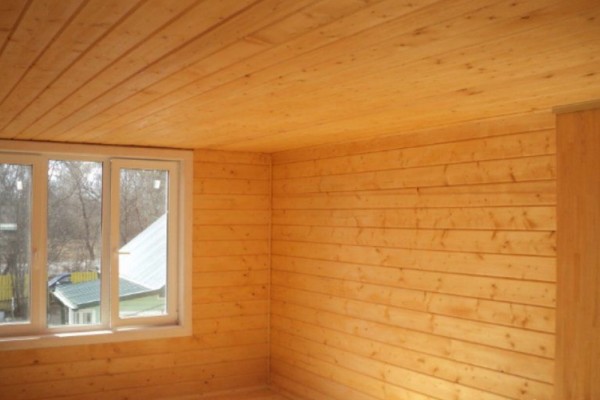
For any out-of-town home, an intelligent option would be internal lining with sheet materials. Such decoration is not very difficult, it allows you to hide layers of insulation and all communications. Experts recommend to leave the disguised access to key places of engineering networks: it is supposed to have removable panels or decorated niche doors.
The most popular material from this category is drywall, on which you can paste wallpaper, lay a tile or create amazing fantasy compositions with decorative plaster and paint. Less commonly used wall panels made of wood raw materials. Hypoallergenic and ecological surfaces are suitable for decorating wallpaper of different quality or painting with modern breathable compounds.
Such decoration is universal, democratic and does not reduce the dignity of a natural wooden massif. To install drywall or lightweight panels, you will need to build a framework of metal profile. If there are no additional conditions, then the distance from the wall will not exceed 5-7 cm. If there are pipes or cables laid along the walls, the structure is installed in accordance with the standards of technical safety. Sheets are easily modeled, from them are easily created architectural delights: arches, special partitions.
If the age of the timber house is solid and the shrinkage remains in the past, the interior decoration of the premises can completely replicate the urban interior: all kinds of plaster, putty with various additives are suitable. With this option of creating comfort, imitations in 3D format will be appropriate - there are appropriate false panels and wallpapers for sale.
A fashionable and having many design options remains the inner material. Applicable lining, a block of houses, less often used recessed pressed lamellae or MDF panels. Technically, the installation of the lining and the Hausa block are very similar: a strong frame of boards is required, located around the perimeter of the room and reliable fasteners. Modern decorative elements are equipped with special locking joints, ensuring tight fit of the strips to each other. And fasteners can have colored or decorated hats, which will be very convenient, if later the surface is planned to simply varnish. Such a coating of processed wood raw materials remains the most environmentally friendly and creates a complete illusion of a real natural log.
The panels, whose lamellas are glued along the length, are considered a budget and multivariate material, allowing to create the most daring interiors: from soft muffled imitations of a wooden whole house to avant-garde combinations of saturated colors. The most popular and in demand today are wall panels with the "groove-comb" attachment system - a reliable latch, which even an amateur can easily handle.
The choice of materials and technologies allows each owner to create in his house from a modern beam a small cozy world and to find spiritual comfort far from the city bustle.
